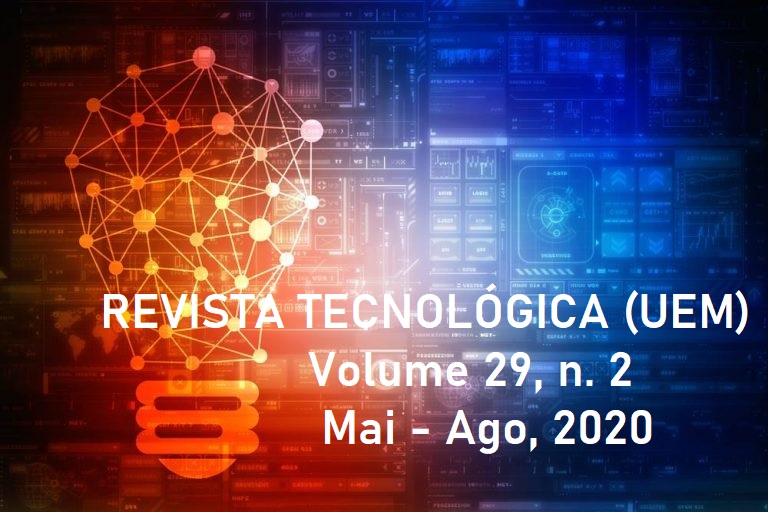PREDICTION OF EXPERIMENTAL TIME FOR FILTER PRESSING: A STUDY FROM EMPIRICAL AND THEORETICAL DATA
Abstract
Filtration is a method of mechanical particle separation using a filter medium to dissociate solid particles from a liquid. Among the types of filtration, the vacuum filter and the filter press stand out, which have different scales and applications. The vacuum filter can be used as a bench scale to determine optimum operating conditions on a press filter, thus avoiding large scale testing. Bench scale filtration was performed using 1 L of calcium carbonate solution (CaCO3), and experiments to determine parameters such as cake resistivity and filter media resistance were performed with the jeans fabric. From the theory of incompressible cake filtration, it was possible to estimate the relationship between the filtration time and the area of the filter medium, with tests performed on a vacuum filter. By adjusting the filtration time on a 20 L volume filter press for the same concentration conditions and filter media, the expected suspension filtration time of 8min and 47s was predicted using an equivalent filtration area 0.16 m², and finally the total filtration time of 6 min and 23s was obtained. Therefore, the result obtained is within the expected time for filtration, considering that the operating differences of the filter press cause an experimental improvement over the vacuum filter.
Downloads
References
BASTOSA, A. R.; AFONSOB, J. C. SEPARAÇÃO SÓLIDO-LÍQUIDO: CENTRÍFUGAS E PAPÉIS DE FILTRO. Quim. Nova, v. 38, n. 5, p. 749–756, 2015. Disponível em: <http://www.scielo.br/pdf/qn/v38n5/0100-4042-qn-38-05-0749.pdf>.
GAUTO, MARCELO ANTUNES; ROSA, G. R. Processos e Operações Unitárias da Indústria Química. [s.l: s.n.]
MCCABE, W. L.; SMITH, J. C.; HARRIOTT, P. Unit Operations Of Chemical Engineering. 5. Ed, p. 1-1154, 1993.
SILVA, M. R. DA; FREITAS, R. F.; SILVEIRA, R. B. DA. FILTRAÇÃO. p. 1–29, 2012.
SILVA, G. D. de F.; DUARTE, L. P. Técnicas Básicas de Laboratório de Química II. Editora UF ed. [s.l: s.n.]
JOSÉ, E.; LOPES, D. S.; MACHADO, R. P.; GONZALES, F.; MUNDIM, L.; RODRIGUES, A. Padronização do corante natural extraído à partir do urucum (Bixa orellana) e sua aplicação na histologia. Collection Health, v. 11, n. 4, p. 1–12, 2019.
MCCABE, W. L.; SMITH, J. C.; HARRIOTT, P. Unit Operations Of Chemical Engineering. 5. Ed, p. 1-1154, 1993.
OTENIO, M. H.; PANCHONI, L. C.; CORREIA, G.; RAVANHANI, C. AVALIAÇÃO EM ESCALA LABORATORIAL DA UTILIZAÇÃO DO PROCESSO ELETROLÍTICO NO TRATAMENTO DE ÁGUAS. Química Nova, v. 31, n. 3, p. 508–513, 2008.
SILVA, M. R. DA; FREITAS, R. F.; SILVEIRA, R. B. DA. FILTRAÇÃO. p. 1–29, 2012.
SOUSA, V. M.; COSTA, L.; FOGAÇA, S. Perfil Físico-Químico de Cervejas Artesanais e Industriais e Adequação dos Rótulos Quanto à sua Graduação Alcoólica. Multidisciplinar e de Psicologia, v. 13, p. 440–447, 2019.
UENOJO, M.; PASTORE, G. M. Pectinases: Aplicações industriais e perspectivas. Quimica Nova, v. 30, n. 2, p. 388–394, 2007.
Os autores podem manter os direitos autorais pelo seu trabalho, mas repassam direitos de primeira publicação à revista. A revista poderá usar o trabalho para fins não-comerciais, incluindo direito de enviar o trabalho em bases de dados de Acesso Livre.










